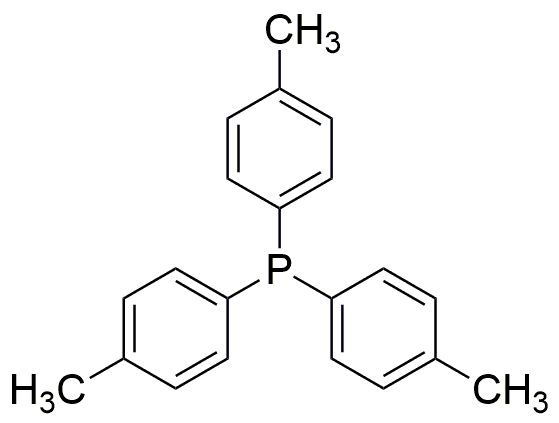Tri(p-tolyl)phosphine is widely utilized in research focused on:
- Catalysis: This compound serves as an effective ligand in various catalytic processes, particularly in palladium-catalyzed cross-coupling reactions, which are essential in organic synthesis.
- Organic Synthesis: It is used to facilitate the formation of carbon-carbon bonds, making it invaluable in the production of pharmaceuticals and fine chemicals.
- Material Science: The compound plays a role in the development of advanced materials, including polymers and nanomaterials, due to its ability to stabilize metal complexes.
- Research in Coordination Chemistry: Tri(p-tolyl)phosphine is a key component in studying coordination compounds, helping researchers understand metal-ligand interactions.
- Pharmaceutical Development: Its application in drug synthesis allows for the creation of complex molecular structures, enhancing the efficiency of drug discovery and development processes.
General Information
Properties
Safety and Regulations
Applications
Tri(p-tolyl)phosphine is widely utilized in research focused on:
- Catalysis: This compound serves as an effective ligand in various catalytic processes, particularly in palladium-catalyzed cross-coupling reactions, which are essential in organic synthesis.
- Organic Synthesis: It is used to facilitate the formation of carbon-carbon bonds, making it invaluable in the production of pharmaceuticals and fine chemicals.
- Material Science: The compound plays a role in the development of advanced materials, including polymers and nanomaterials, due to its ability to stabilize metal complexes.
- Research in Coordination Chemistry: Tri(p-tolyl)phosphine is a key component in studying coordination compounds, helping researchers understand metal-ligand interactions.
- Pharmaceutical Development: Its application in drug synthesis allows for the creation of complex molecular structures, enhancing the efficiency of drug discovery and development processes.
Documents
Safety Data Sheets (SDS)
The SDS provides comprehensive safety information on handling, storage, and disposal of the product.
Product Specification (PS)
The PS provides a comprehensive breakdown of the product’s properties, including chemical composition, physical state, purity, and storage requirements. It also details acceptable quality ranges and the product's intended applications.
Certificates of Analysis (COA)
Search for Certificates of Analysis (COA) by entering the products Lot Number. Lot and Batch Numbers can be found on a product’s label following the words ‘Lot’ or ‘Batch’.
*Catalog Number
*Lot Number
Certificates Of Origin (COO)
This COO confirms the country where the product was manufactured, and also details the materials and components used in it and whether it is derived from natural, synthetic, or other specific sources. This certificate may be required for customs, trade, and regulatory compliance.
*Catalog Number
*Lot Number
Safety Data Sheets (SDS)
The SDS provides comprehensive safety information on handling, storage, and disposal of the product.
DownloadProduct Specification (PS)
The PS provides a comprehensive breakdown of the product’s properties, including chemical composition, physical state, purity, and storage requirements. It also details acceptable quality ranges and the product's intended applications.
DownloadCertificates of Analysis (COA)
Search for Certificates of Analysis (COA) by entering the products Lot Number. Lot and Batch Numbers can be found on a product’s label following the words ‘Lot’ or ‘Batch’.
*Catalog Number
*Lot Number
Certificates Of Origin (COO)
This COO confirms the country where the product was manufactured, and also details the materials and components used in it and whether it is derived from natural, synthetic, or other specific sources. This certificate may be required for customs, trade, and regulatory compliance.


